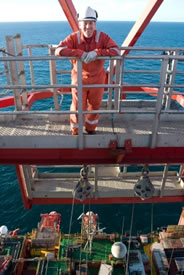When natural gasses and oil accumulate under the sea floor, offshore exploration and production is the method that the oil and gas companies use to extract them. As a nation we only drill into a portion of our reserves at this point, but more and more pressure is being put on the administration in order to increase drilling. Historically the largest reservoirs have been found near Texas, California, Louisiana and Alaska. However, there are new hotspots, like North Dakota and others all around the world, that are still being discovered. The Arctic shelf holds massive amounts of oil, and when permits are finally issued to drill there, the industry will expand even more.
Drilling for offshore oil domestically is likely the path of the future. There are four different sections of an area that are utilized when drilling for oil and gas, and they range from onshore to offshore. Throughout the last decade, the biggest and best sources have been found out in deep-water. In fact, deep-water drilling makes up approximately half of all drilling done in the world, and as more hotspots are being discovered and drilled, the need for workers to join off shore drilling platforms continues to grow.
Offshore Oil on a Global Scale
 The oil and gas industry is one of the largest and most important industries in the world. It not only accounts for 50 percent of the world's energy needs, but it also provides 80 percent of the world's transport fuel needs. This includes not only cars and trucks, but also the freight trains and carrier ships that transport goods from state to state and continent to continent. Oil and gas make up for more of the global energy supplies than all of the other sources added together. As the world population grows annually, so does our need for more energy so we can maintain our current standard of living. And many countries are attempting to increase their own standard of living, which will require even more energy.
The oil and gas industry is one of the largest and most important industries in the world. It not only accounts for 50 percent of the world's energy needs, but it also provides 80 percent of the world's transport fuel needs. This includes not only cars and trucks, but also the freight trains and carrier ships that transport goods from state to state and continent to continent. Oil and gas make up for more of the global energy supplies than all of the other sources added together. As the world population grows annually, so does our need for more energy so we can maintain our current standard of living. And many countries are attempting to increase their own standard of living, which will require even more energy.
There are currently more than 500 companies globally around the world drilling for oil and gas. This means not only are they exploring places far out in the ocean where they have never drilled before, but they are also drilling deeper. Technology is one of the main driving forces of the entire industry, so if deeper is better than deeper they go. Using technology allows digging deeper, which will allow us to reach reserves that weren't accessible before now.
With each new discovery and technological advance come job opportunities for skilled workers. Jobs on an offshore rig require strength, determination and bravery, but will provide a great income, job security and career advancement opportunities. Tapping into new reserves is like reaching the moon and planting your flag - it's a race and everyone wants to win by being the first ones there.
Did You Know? The top 10 crude oil producers in the world are Saudi Arabia, Iran, Russia, The United States of America, Canada, Norway, United Arab Emirates, Mexico, Venezuela, and China. Only 3 of the countries are also in the top 10 consumers of the world.
US Offshore Oil Industry
Anyone who owns a car knows what it's like to be part of the oil and gas industry to an extent - at least you've likely felt the effects of the industry in your own pocketbook.
As we all experience the rise and fall of gas prices, we are getting a glimpse into the global gas and oil industry. As the price of gas goes up at your local gas station, gas production starts to increase and so does the amount of job openings. If the past is any indication of the future, we can expect the production of oil and gas to robustly continue, and that means that oil and gas companies need skilled workers now.
One reason this is so important is because the U.S. has one of the highest percentages of untapped oil reserves. Some calculate it to be the largest ever known. That's right - even though we import large amounts of oil from other countries, we have more untapped oil reserves than most countries have ever had. And as the years pass, it will become more necessary for the U.S. to drill into these reserves so that more jobs will be created and we won't be reliant on other sources for fuel. In short, the offshore oil sector is just beginning to boom, and there doesn't appear to be any end in sight.
Did You Know? The United States has a capacity of 727,000,000 barrels in its Strategic Petroleum Reserve. If filled, it could replace about 60 days of oil imports.
There is no bigger industry on a global level than oil and gas, nor is there an industry that impacts our daily lives on so many different levels. The key to the future of the industry lies in offshore drilling, but that is just one piece of the puzzle. We will continue to explore the oil and gas industry next as we talk about an overview of natural gas jobs.
Offshore Oil Job Overview Summary
- The global need for more oil and gas increases everyday and so does the need for skilled workers.
- As our global and local needs increase, so does our economy, which drives the market up.
- As the industry grows, it creates new jobs and national revenue for all Americans.
- The U.S. has the largest reserve in the world ever reported and we have only begun to drill into it.
- Offshore deep-water reserves account for half of the known oil and gas supply in the world


 View the Latest Cool Job Listings
View the Latest Cool Job Listings Sharing Economy
Sharing Economy Ski - Snowboard Jobs
Ski - Snowboard Jobs Cruise Ship Jobs
Cruise Ship Jobs